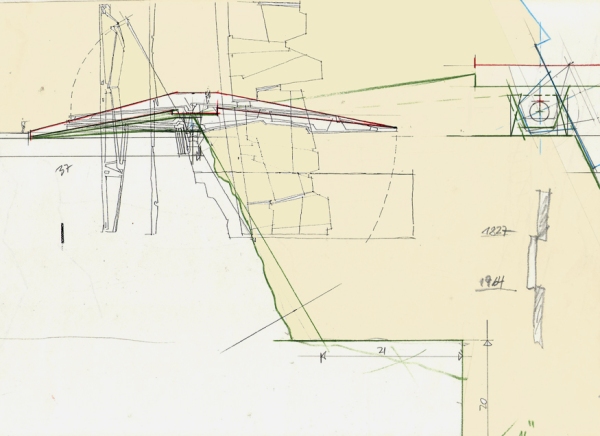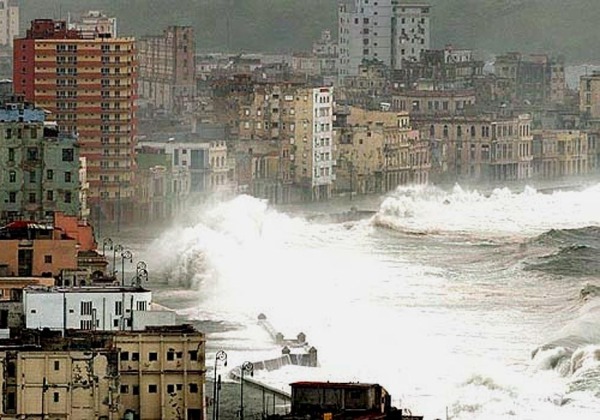ON THE MALECÓN
(above) El Malecón de la Habana—The Malecón—in good weather. The sea-wall on The Malecón on a typical day:
Along the north side of Havana, facing the Caribbean and the often-cited ninety miles to the barren Florida keys, is a long road bordering the sea. This is The Malecón. It is both a lively and forbidding public space—the former because the sea sends waves crashing against a sheer seawall footed on black rocks below, and people come there to walk or sit on the wall to watch and feel and taste the sea—the latter because it is primarily a space for automobiles. Granted that there are not so many because of a perennial shortage of gasoline, but this doesn’t alter the character of the space: it is a bare, inhospitable roadway separating the city and its people from the pleasures of the warm tropical waters. Granted, as well, that there is no natural beach along this stretch and the land itself drops abruptly to some depth beneath the surging water; and also, as a result, that the water is too turbulent for swimming. Still, it seems that something could be done to make The Malecón a more hospitable space next to the sea for the people of the city.
There is another feature of The Malecón to be considered. When hurricanes move across the island or the sea, the sea-level rises and the waves become larger and more violent, often flooding The Malecón and its neighborhoods. Every fifty years or so, there is a particularly large storm with winds that drive the sea in a massive storm-surge that floods many lower-lying parts of the city, including those such as la Habana Vieja, the old Spanish colonial city, housing poorer people—a situation similar to the Ninth Ward in New Orleans, which was inundated by a storm surge from a fifty-year storm—Hurricane Katrina—in 2005. The Cuban government has called for engineering proposals to protect against such catastrophic events. However, because of the nation’s depressed economy—the result of following Soviet Bloc models as well as the fifty-year trade embargo by the United States—the money to pay for solutions on the scale of, say, The Netherlands Delta Works is not available nor likely to be in the near future. Havana remains vulnerable.
In spite of the economic barriers to realizing at the present time any large-scale projects, new proposals need to be made. One cannot simply shrug at the impossibility and walk away from the problems. Political situations are changing, and with them the prospects for international cooperation in solving Cuba’s urgent human needs, including flood control for Havana.
It has seemed to me that the problem of making public space on The Malecón and the construction of a barrier to destructive storm-surges could be solved by a single project, which I have proposed and which is shown in schematic form below. Constructed on the land—instead of in the sea, as many proposals have envisioned—it could be realized as a labor-intensive rather than capital-intensive project. Even so, it would require a determined commitment not only by the government, but also by the people of the city. The problems to be solved are large and extensive and can only be addressed by large and extensive proposals. Halfway measures and symbolic gestures are worse than inadequate—they waste both resources and the hope of actually improving conditions.
In brief, the proposal calls for the construction of a terrace along the six-kilometers of The Malecón, which is dedicated to public recreation, a type of urban park or abstract beach cantilevered from The Malecón over the sea. Shelter from the sun is built into the layers of each structurally independent terrace segment, which rests on heavy steel hinges such as those used for modern drawbridges. The independent segments can be built one at a time, and also shaped to the curving line of the roadway, so that their ensemble is continuous. Most importantly the segments can be designed to accommodate differing recreational needs along its six-kilometer extent; for example, a set of terrace segments serving one neighborhood could be very open, while another, serving a different neighborhood, could provide more layers of shelter and semi-enclosed spaces. The schematic design shown here only begins to suggest the possible variations.
When the weather turns bad and a passing hurricane raises the sea-level and sends a storm surge of water onto the shore, the force of this surge activates a ballast system within the terrace segments and rotates them on their hinges into a near-vertical position, creating a strong, high seawall that holds back the surging water. When the storm passes and the water recedes, the segments rotate back into their original positions. The idea is that the sea itself initiates and provides the energy for operating the system—no added mechanical systems to install and maintain—a sustainable system, in the contemporary sense.
Section through the six-kilometer long terrace, cantilevered over the sea—an artificial beach dedicated, in good weather, to public play and recreation:
Model section showing the steel structure of a terrace segment and bridge-type steel hinges:
Plan of several terrace segments:
Section through terrace segments at normal sea levels:
Typical terrace (looking back at the city):
The Malecón during a hurricane—not yet the fifty-year storm surge. Note the height of the sea, and the beginning of flooding:
The force of the waves rotates the terrace segments all along The Malecón into a seawall position:
Section through terrace segments in seawall position during a storm surge:
View of terrace segments in seawall position (looking back to the city):
Note: Model designed and built in collaboration with Ekkehard Rehfeld.
LW
About this entry
You’re currently reading “ON THE MALECÓN,” an entry on LEBBEUS WOODS
- Published:
- January 1, 2010 / 9:40 pm
- Category:
- Lebbeus Woods
- Tags:















22 Comments
Jump to comment form | comment rss [?] | trackback uri [?]